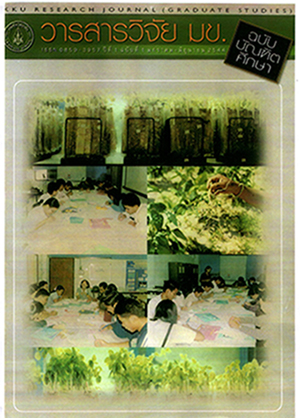Stressors and coping methods in Chronic hemodialysis patients (สิ่งที่ก่อให้เกิดความเครียดและวิธีการเผชิญปัญหาในผู้ป่วยไตวายเรื้อรัง ที่รักษาด้วยเครื่องไตเทียม)
Keywords:
Stressors, coping methods, hemodialysis patientsAbstract
The purpose of this study was describe about stressors and coping methods in chronic hemodialysis patients based on Lazarus and Folkmans conceptual framework (1984). A descriptive survey design was utilized. The sample was used for this research comprised 73 hemodidalysis patients. They were from the governmental hospitals : Sappasithiprasong Hospital and Sappasithiprasong Military Hospital. Some of them, were from private hospitals : Ubonrakthonburi Hospital and Rajchavet Hospital. Moreover, other were taken from a private clinic : Nirun Hemodialysis in Ubon ratchathani. The samples were out-patient hemodialysis aged over 20 years old. The data were collected from February to March 2000. The instruments that used for data collection as 1) demographic data, 2) A Hemodialysis Stressors Scale with 29 questions modified from Baldree et al. (1982). Reliability of the instruments was examined using Cronbach Coefficient alpha obtained was 0.88. and 3) Coping methods using four open-ended questions. The Statistical procedure used frequency, percentage in quantitative data on stressors and coping methods. The quality data in interview patients were analyzed for content analysis. The results were as follow: 1) Fatigue was the highest stressor (65.75%). Cost factor for hemodialysis patients were the highest severity of stress (55%). 2) The subjects used multiple coping methods: problem- oriented coping methods and emotion- oriented coping methods. The most frequently used confrontive coping was maintain control (72.60%). Second to that the palliative coping for helping patients to resign themselves from these situations when things look hopeless (53.42%). The last method was, using two emotive coping : anxiety and frustration (42.46%). The study finding can be used as a guideline for nursing care plans which serve to promote in effective coping and quality of life in individual hemodialysis patient.
ารวิจัยครั้งนี้มีจุดประสงค์เพื่อบรรยายถึงสิ่งที่ก่อให้เกิดความเครียดและวิธีการ เผชิญปัญหาในผู้ป่วยไตวายเรื้อรังที่รักษาด้วยเครื่องไตเทียม ภายใต้กรอบแนวคิด ทฤษฎีของลาซารัสและโฟล์คแมน (Lazarus & Folkman, 1984) การออกแบบการวิจัย เป็นการวิจัยเชิงบรรยาย กลุ่มตัวอย่างที่ใช้ในการวิจัย คือผู้ป่วยโรคไตวายเรื้อรังที่รักษา ด้วยเครื่องไตเทียมที่มารับการรักษาที่หน่วยไตเทียม โรงพยาบาลของรัฐ 2 แห่ง ได้แก่ โรงพยาบาลสรรพสิทธิประสงค์และโรงพยาบาลค่ายสรรพสิทธิประสงค์ โรงพยาบาล เอกชน 2 แห่ง และคลินิกเอกชน 1 แห่ง ได้แก่ โรงพยาบาลอุบลรักษ์ธนบุรี โรงพยาบาล ราชเวชและคลินิกไตเทียมนิรันดร์การแพทย์ โดยกลุ่มตัวอย่างมีอายุ 20 ปีขึ้นไป ยินดี ให้ความร่วมมือในการศึกษาและสามารถให้ข้อมูลได้ เก็บข้อมูลระหว่างเดือนกุมภาพันธ์ ถึงเดือน มีนาคม 2543 จำนวนทั้งสิ้น 73 ราย เครื่องมือที่ใช้ในการวิจัยคือ 1) แบบบันทึก ข้อมูลทั่วไป 2) แบบสัมภาษณ์สิ่งที่ก่อให้เกิดความเครียดของผู้ป่วยไตวายเรื้อรังที่รักษา ด้วยเครื่องไตเทียม (Hemodialysis stressors scale, HSS) ที่แปลและเรียบเรียงจาก Baldree et al. (1982) เครื่องมือที่ใช้ได้ผ่านการหาค่าความเที่ยง โดยใช้ค่าสัมประสิทธิ์ แอลฟ่าของครอนบาค เท่ากับ 0.88 และ 3) แบบสัมภาษณ์วิธีการเผชิญปัญหาซึ่งเป็น คำถามปลายเปิด การวิเคราะห์ข้อมูลเชิงปริมาณ ในสิ่งที่ก่อให้เกิดความเครียดและวิธี การเผชิญปัญหา ใช้สถิติบรรยายคือ การแจกแจงความถี่ ร้อยละ ส่วนข้อมูลเชิงคุณภาพ ที่ได้จากการสัมภาษณ์ ใช้การวิเคราะห์เนื้อหา ผลการวิจัยสรุปได้ดังนี้ 1. ความอ่อนล้า เพลีย เป็นสิ่งที่ก่อให้เกิดความเครียดที่พบมากที่สุด (ร้อยละ 65.75) ปัญหาค่าใช้จ่ายในการฟอกเลือดมีระดับความรุนแรงของความเครียดในผู้ป่วยไตวาย เรื้อรังที่รักษาด้วยเครื่องไตเทียม มากที่สุด (ร้อยละ 55.00) 2. กลุ่มตัวอย่างใช้วิธีการเผชิญปัญหา 2 ด้านร่วมกัน คือ ด้านการมุ่งแก้ปัญหา (problem-focused coping) และด้านการมุ่งปรับสภาพอารมณ์ (emotional-focused coping) กลุ่มตัวอย่างใช้การเผชิญปัญหาด้านการเผชิญหน้ากับปัญหามากที่สุด วิธีที่ใช้ คือ พยายามควบคุมสถานการณ์ (ร้อยละ 72.60) รองลงมาคือ การเผชิญปัญหาด้านการ บรรเทาความรู้สึกเครียด วิธีที่ใช้คือให้เลิกคิดเกี่ยวกับเหตุการณ์เพราะดูแล้วคงไม่มีทาง ทำใจ/ปลง (ร้อยละ 53.42) และสุดท้ายการเผชิญปัญหาด้านการจัดการกับอารมณ์ วิธี ที่ใช้คือหงุดหงิด/กระวนกระวายใจ (ร้อยละ 42.46) ผลการวิจัยครั้งนี้ สามารถนำไปใช้เป็นแนวทางในการวางแผนการพยาบาล เพื่อส่งเสริม ให้ผู้ป่วยไตวายเรื้อรังที่รักษาด้วยเครื่องไตเทียมแต่ละราย สามารถเผชิญปัญหาได้อย่าง ถูกต้องเหมาะสมและมีคุณภาพชีวิตที่ดีต่อไป



